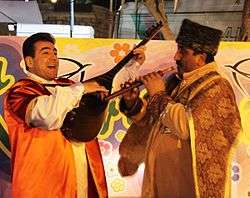Santur
 | |
| String | |
|---|---|
| Classification | Stringed, Struck |
| Playing range | |
 | |
| Related instruments | |
| Hammered Dulcimer | |
 |
[[:File:Sadeghi-Dehlavi-Concertino for Santur Full.ogg|]]
|
| Problems playing this file? See media help. | |


The santur (also santūr, santour, santoor ) (Persian: سنتور) is a hammered dulcimer of Iranian origin[1][2] The term Santur originated with meaning "100 strings[1]
Description
The oval-shaped Mezrabs (mallets) are feather-weight and are held between the thumb, index and middle fingers. A typical Persian santur has two sets of bridges, providing a range of approximately three octaves. The right-hand strings are made of brass or copper,[3] while the left-hand strings are made of steel.[4] Two rows of 9 bridges called "kharak." A total of 18 bridges divide the santur into three positions. Over each bridge crosses four strings tuned in unison, spanning horizontally across the right and left side of the instrument. There are three sections of nine pitches: each for the bass, middle and higher octave called Poshte Kharak (behind the left bridges) comprising 27 notes all together. The top "F" note is repeated 2 times, creating a total of 25 separate tones in the Santur. The Persian santur is primarily tuned to a variety of different diatonic scales utilizing 1/4 tones (semi-tones) which are designated into 12 modes (Dastgahs) of Persian classical music. These 12 Dastgahs are the repertory of Persian classical music known as the Radif.
Derivations
Similar musical instruments have been present since medieval times all over the world, including India, Afghanistan, Pakistan, Armenia, Turkey, Iraq and Greece, China etc. The Indian santoor is wider, more rectangular and has more strings. Its corresponding mallets are also held differently played with a different technique. The Chinese yangqin and the Greek santouri also derived from the santur. The eastern Europe version of the santur called the cimballum which is much larger and chromatic is used as an accompanying instrument in gypsy music.
Image information is incorrect. part of persian miniature by Ebrahim Jabbar Beik, contemporary iranian artist.
Notable Persian santur players
Iran
- Abol Hassan Saba
- Manoochehr Sadeghi
- Faramarz Payvar
- Parviz Meshkatian
- Majid Kiani[5]
- Mohammad Sadeq Khan[6]
- Ali Akbar Shahi[7]
- Hassan Khan[8]
- Hussein Malek[9]
- Habib Soma’i[10]
- Reza Varzandeh[11]
- Reza Shafieian[12]
- Mansur Sarami[13]
- Masoud Shaari[14]
- Mohammad Santour Khan[15]
- Daryoush Safvat[16]
- Jalal Akhbari[17]
- Ardavan Kamkar
- Pejman Azarmina
- Siamak Aghaei
- Pashang Kamkar
- Kourosh Zolani
- Alireza Hajizadeh
- Arfa Atrai[18]
- Azar Hashemi[19]
- Susan Aslani[20]
- Manijeh Ali Pour[21]
- Hayaf Yassine
- Masoud Malek- Ostad Masoud Malek- Solo Santour Chahargah
- Maryam Saffarian
Santur players from other cultures
Greece
(Greek Santoori)
India (see Indian santoor)
Iraq
Japan
Germany (Dr. Bee Seavers) disciple of Pt. Shivkumar Sharma www.shantiniketan.eu
Santurs from around the world
Versions of the santur or hammered dulcimer are used throughout the world. In Eastern Europe, a larger descendant of the hammered dulcimer called the cimbalom is played and has been used by a number of classical composers, including Zoltán Kodály, Igor Stravinsky and Pierre Boulez, and more recently, in a different musical context, by Blue Man Group. The khim is the name of both the Thai and the Khmer hammered dulcimer. The Chinese yangqin is a type of hammered dulcimer that originated in Persia. The santur and santoor are found in the Middle East and India, respectively.
|
See also
- Santur related pictures
-

Typical Iraqi Santur
-

Chalghi Santur Player playing on a non-standard Iraqi Santur
-

Santur Hand Position
-
Santur Technique Video.theora
References
- 1 2 Farrokh, Kaveh (2007). Shadows in the desert : ancient Persia at war (1. publ. in Great Britain ed.). Oxford, UK: Osprey. p. 286. ISBN 9781846031083.
- ↑ "Santur is a hammered dulcimer, consisting of a trapezoidal box with horizontal strings, played with oval shaped featherweight mallets known as mezrab.". Art Max Academy.
- ↑ "Bass strings made of Brass or Copper". Art Max Academy.
- ↑ "Different kinds of Steel exist". Art Max Academy.
- ↑ Kiani, Majid. "Master of the Santur". Santur Master, Teacher & Performer.
- ↑ Khan, Mohammad Sadeq. "One of the oldest Santur Masters". Master of the Santur.
- ↑ Shahi, Ali Akbar. "Santur master". Old school santur player.
- ↑ Khan, Hassan. "Santur Master". Old school Santur Master.
- ↑ Malek, Hussein. "Santur master". Old School Santur Master.
- ↑ Somai, Habib. "santur master". Old school Santur master.
- ↑ Varzandeh, Reza. "Santur Master". Unique Style of Playing.
- ↑ Shafieian, Reza. "Saba's Student". Santur Master.
- ↑ Sarami, Mansur. "Santur Master". Old School Santur player.
- ↑ Shaari, Masoud. "Santur Master". Old School Santur Master.
- ↑ Khan, Mohammad Santour. "Oldest Santur Master that we have proof of". Master of the Santur.
- ↑ Safvat, Daryoush. "Santur Master". Old school Santur master.
- ↑ Akhbari, Jalal. "Old School Santur Master". Master of the Santur.
- ↑ Arfa, Atrai. "Santur Player". Santur Soloist.
- ↑ Hashemi, Azar. "Female Santur Player". Santur Soloist.
- ↑ Aslani, Susan. "Female Santur Player". Santur Soloist.
- ↑ Ali Pour, Manijeh. "Female Santur Player". Old School Santur Player.
- ↑ Tani, Dr. Masato. "Japanese Santur Player". Ethnomusicology.
- ↑ "Santurs from different cultures". Wikipedia.
External links
- Santur - The Art of Persian Music
- Santur introduction in American Lutherie magazine
- Nay-Nava Encyclopedia entry on the santur
- Dr. Ümit Mutlu's information on the santur (in Turkish)
- Santur history (in Turkish)
- The Iraqi Santur
Further reading
Heydarian, P.; J.D. Reiss (2005). "The Persian music and the santur instrument" (PDF). Proceedings of Sixth International Conference on Music Information Retrieval, London, UK. pp. 524–527.
| |||||||||||||||||||||||||||||||||||||||
| ||||||||||||||||||||
| ||||||||||||||||||||
| ||||||||||||||||||
| Wikimedia Commons has media related to Persian santur. |





